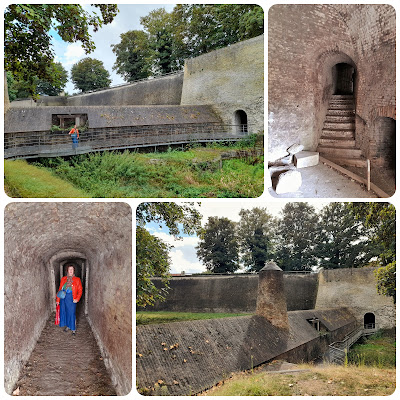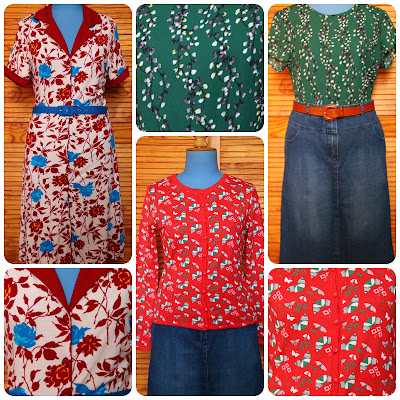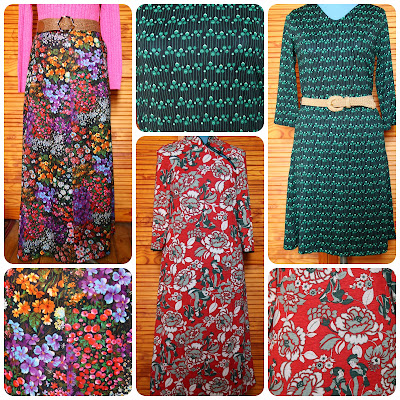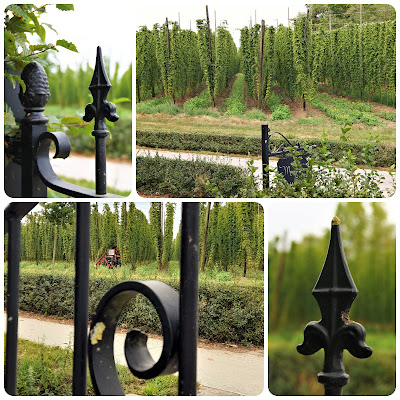Hello, and welcome to the third chapter of my travelogue covering our latest little getaway.
After another rainy night, we woke up to hesitant sunshine on Thursday the 8th of September. While we were having breakfast, the sun did her best to trick us into thinking it would be a glorious day. Our phone's weather app, however, told us quite a different story, promising showers throughout the day.
Not to be fazed, we decided to go ahead with our plans, which involved half-an-hour's journey and crossing the border into France. Our destination for the day, the compact little walled town of Bergues, in the French region of Hauts-de-France.
With the mercury not expected to climb higher than 19 to 20°C, I opted for long sleeves, and selected this green and navy Breton striped top from my travel capsule. It was charity shopped just weeks before our Shropshire holiday, during which it certainly proved its merits, as I wore it twice.
The denim skirt was found in a Shrewsbury charity shop, and its generous side slips makes it perfect for walking. The blue belt with its green stitching was a sales bargain from Mango this Summer, while the necklace and brooch were old charity shop and flea market finds respectively. My feet thanked me for wearing my comfortable walking shoes, which would be my footwear of choice on most days.
Blue skies and sunshine accompanied us on our journey, which took us through a succession of picturesque Flemish villages which had ended up on the wrong side of the border, until we reached the A25 motorway. We only had to take this for a short stretch before reaching the exit to Bergues. From here, we followed directions to the Place de Marché aux Bestiaux (Cattle Market), where we'd parked last time we were here, in 2018. After finding a convenient spot for our chariot, we set off to the town centre.
The blue wooden building is home to the market's cattle scales and apparently it is still in use. It had clearly undergone quite a transformation at some point since our last visit (see
here) as its paintwork was looking spick-and-span.
If you are wondering about the Ch'ti sign on the top right, it is the nickname given to the inhabitants of the town, a reference to their - according to their Southern compatriots - undecipherable dialect and unsophisticated ways. But then Bergues became popular overnight with the successful French comedy, "Bienvenue chez les Ch'tis", which was filmed in Bergues and released in 2008, and tourists started flocking to the town.
The cattle market shack wasn't the only edifice to have received a total transformation since we were last here. Indeed, back in 2018 the town's most celebrated and certainly most eye-catching monument, the 47 metres-high belfry, was hidden by scaffolding and its 50-bell carillon was shrouded in silence.
Now, in contrast, we could hear the pealing of its bells the minute we stepped out of our car, and long before the magnificently restored tower came into view. The current belfry, which dates from 1961 and is the building's third incarnation, has been a UNESCO World Heritage Site since 2005. It was rebuilt in 1961 following its destruction by fire in 1940 and dynamiting by the Germans in 1944.

Next to the belfry's entrance, a giant wearing a top hat and dressed in a frock coat was seated. He is one of the Giants of the North, representing historical, legendary or fictional characters, which are a long-standing tradition in this part of the world. This particular one was created in 1913 to commemorate the 80th anniversary of the election of Alphonse de Lamartine as deputy for Bergues in 1833. He has recently received a change of costume and has moved to his current spot from the town hall opposite this Summer. Note that he is also carrying an large black umbrella (just visible in the photo on the top right), which is also known as a "berguenard"!
berguenard \bɛʁ.ɡə.naʁ\ masculin
Grand parapluie que l’on sort pour le carnaval. (Note : à l'origine c'était les habitants de Bergues qui les utilisaient).
Transl.: Large umbrella used for carnaval, so called because it was originally used by the inhabitants of Bergues

On the occasion of our previous visit, we did a 5,2 kilometer walk which mainly took us along the town's extensive ramparts. This time, we had no real itinerary other than drifting around the town, just following our noses and anything that caught our eye.
I indulged in my passion for photographing interesting doorways as well as miscellaneous oddities and curiosities, such as the ceramic house name sign on the top right, its name (The White Horse House) being in Flemish rather than French.
We crossed the Place de la Republique and admired the fine Flemish-style town-hall which was initially built in 1665 in another location and relocated, stone by stone, to its current one in 1871.
And look who me met there, no less than Mr. Alphonse de Lamartine, albeit this time sans top hat, frock coat and berguenard!
From here, we continued along the Rue des Annonciades, until we reached the Groenberg (transl. green hill), a 22-metre high hillock overlooking the swampy region south of the sandy beaches of Dunkirk, where Bergues was founded in 857. In 885, the town was fortified by Baudoin the Bald, Count of Flanders. He entrusted the local religious authorities with the relics of Saint-Winoc, a patron saint who converted the region to Christianity at the end of the 7th century.
Beyond the magnificent marble gate we could now see in front of us are the ruins of the Benedictine abbey of Saint Winoc which was founded in 1022, and remained very influential until the French Revolution. The Porte de Marbre was originally the entrance gate to the courtyard of the abbey palace.
Only the Square and Pointed Towers survived the destruction of the abbey, in their capacity as navigational landmarks. Ships entering the Dunkirk channel were guided safely by the two towers of Bergues.
The town acquired the site at the beginning of the 20th century and turned it into a public garden.
As it was nearly lunch time by now, we sat ourselves on a bench in the garden as, rather than return to the town centre, we were adamant to revisit a gem of a place we discovered back in 2018.
Picturesquely located in the heart of the public garden, L' Aubette appeared like a fata morgana just when hunger pangs started to get the better of us at the time, and its menu certainly did not disappoint.
Nor did it this time around, although there was no way I could finish everything on my plate of couscous with merguez, chicken and lamb.
Dark clouds had been chasing away the fluffy white ones while we were eating and any trace of the formerly blue sky had disappeared by the time we stepped outside. In fact, we hadn't walked very far when it started chucking down, so that we had to open our umbrella and wait out the worst sheltering under some trees.
As soon as the downpour diminished, we made our way back to our car to pick up my waterproof camera bag, by which time the sun had once again made an appearance. Thinking the worst was over, we returned to the town centre to continue our explorations.
The weather gods clearly were in one of their mischievous moods as sunny spells and showers followed each other in quick succession. Even the saintly guy in his little niche (above, top right) was holding up his hands in desperation, while the rain streamed down the faces of the scantily clad three graces guarding the fountain in the Place Saint-Victor.
We took shelter in the parish church of Saint Martin, whose origins date back to the end of the 16th century. The building was badly damaged during the Second World War, most notably on 16 September 1944 – the date of the liberation of Bergues – when the tower was blown up with dynamite. The tower was rebuilt in the 1950s, although not according to the initial design, and only a few parts of the original church remain today.
The interior is illuminated by splendid contemporary yellow-orange stained glass windows.
Dating from the 18th century, the black marble baptismal font (above, top right) is topped by a wooden sculpture representing the baptism of Christ. This is a rare piece as its base rotates to reveal the baptismal font in order for babies to be christened under the benevolent gaze of Christ and Saint John the Baptist.
We left the church once the rain had virtually stopped and walked around its back to the ruins of part of the original church set into a tranquil garden complete with headless statue.
The remarkable building on the left and bottom right, is the former Mont de Piété, dating from 1633, an institutional pawnbroker ran as charity. It is now the home of the municipal museum, which has a large collection of mainly Flemish paintings and drawings dating from the 16th to the 19th century, as well as an extensive natural history collection.
It is possible to walk around the entire length - about 5 kilometers - of the ramparts Bergues is surrounded with. These are partly medieval and partly the work of Vauban - a French military engineer who worked under Louis XIV and generally considered the greatest engineer of his time - and are still complete with their entrance gates and some of their towers.
It was virtually unavoidable that our wanderings eventually took us on a small stretch of them. As I kept lagging behind to take photos, Jos plonked himself down on a conveniently placed post while waiting for me to catch up before continuing on the path skirting the outer town walls.
The rectangular squat tower with its mysterious entrance is the ruin of the medieval Tour des 7 Baraques which, in spite of my claustrophobia, we decided to explore. I do look a bit like a rabbit caught in headlights in the photo on the bottom left.
Before too long, a set of steps took us back to the public garden and L' Aubette, where we rested our feet and enjoyed large cups of cappuccino. Then we made our way back to our car, stopping for a baguette for our evening meal along the way.
By then, the weather gods had finally grown tired of taunting us so that it remained dry for our journey back to Poperinge. Not for long though, as it started raining heavily again minutes after we'd walked through the door.
According to Jos, it had kept raining all through the night and it was still doing so when we woke up on Friday morning. The dark clouds which our phone's weather app insisted would keep coming our way didn't bode well for the rest of the day.
We lingered over breakfast and discussed plans for the day, which we would start with a rummage in the local charity shop, followed by a food shop in the small supermarket in the village up the road.
Tiny it may be, but I've never left the charity shop in Poperinge empty handed. I was in luck again this time, finding a brown embellished skirt by posh Belgian label Caroline Bis and a bird print pussy bow top from a Belgian high street label. Total spend: € 6,50.
The sun came out long enough to make some photos of my new-to-me outfit outside the cottage's front door.
We had lunch at the cottage - consisting of a salad with the rest of the baguette from Bergues - and then drove to Poperinge for a visit to the Hop Museum.
As mentioned in a previous post, the museum is housed in the former Stadsschaal or Municipal Scales, where the hops used to be weighed, inspected and stored. The warehouse's beautifully restored exterior belies its spectacular contemporary interior, where an audio tour guides you through four floors of history and culture, starting from the impressive loft to the ground floor.
As it looked as if yet another shower was imminent, we made some quick outfit photos before going inside. Nothing new here, just my favourite vintage maxi skirt with a short-sleeved knit jumper, my orange leather jacket and the pleated yellow scarf I charity shopped in Bridgnorth in June.
The exhibits include an extensive collection of authentic equipment used for the hop harvest as well as photographs, models and audiovisual presentations illustrating the history of hop culture.
On the ground floor the Belgian Beer Collection, with more than 1,800 Belgian beer arranged by region, can be found, with microbreweries sharing space with the big names.
Unfortunately, a group of school children on an outing was sharing our visit. They were boisterously running around the floors and kept popping in and out of the various rooms so that it was hard to get to some of the exhibits, let alone taking decent photos of them.
However, my deadly stare seemed to do its work once again, especially after I told a couple of them in no uncertain terms that we too had paid an entrance fee, and that they should have the decency to give us some space and wait until we'd finished looking at things. From that moment onwards, they kept saying sorry whenever they got in our way.
After this semi-ordeal, we finished the day with restorative cups of coffee in a café on the market square. No waffles though, as we were informed that the kitchen of our chosen establishment was closed for the day.
Would rain stop play again during the rest of our holiday? You will find out the answer in my next posts!




























.jpg)












.jpg)








